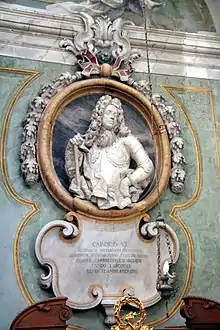Giacomo Colombo
Giacomo Colombo (1663–1730) was an Italian sculptor, painter and engraver, he worked in Naples, Italy in the late 17th and early 18th centuries.
Giacomo Colombo | |
|---|---|
| Born | 1663 |
| Died | 1730 Naples, Italy |
| Occupation | artist |
| Movement | Arcadia, Rococo, Baroque |

Biography
Colombo was born in 1663 in Este, Padua, Italy.[1] He moved to Naples in 1678.[1] Colombo was a student of sculptor, Domenico di Nardo.[1] Colombo's sculptures were made primarily in marble, polychrome wood, and stucco.[2] He also worked on engravings of his work.[2] He worked in the Arcadian–Rococo style.[2]
Colombo worked on Croce di Lucca, a church in Naples, and carved a large-scale organ, created decorative stucco arches, and worked on carving the marble stoups in 1688 working alongside sculptor Pietro de Barberis.[1][2]
Between 1703 and 1704, Colombo was commissioned to create two marble bas-reliefs for the tombs of Anna Maria Arduino, Princess of Piombino from Messina, and her infant son Niccolò II Ludovisi at the church of San Diego all'Ospedaletto.[1][3] Other works by Colombo are found at the chapel of San Vincenzo at Santa Caterina a Formiello (between 1724 and 1726, Naples), Santo Stefano, Capri (1691), San Ginés, Madrid (1698), amongst others.[2]
He died in Naples on 1730.[2]
References
- Moral, Roberto Alonso (2013). The Immaculate Conception by Giacomo Colombo, a sculpture in its Italian context (PDF). Bilbao Fine Arts Museum Foundation, Bilbao Museum of Fine Arts Foundation. pp. 5–6.
- Borrelli, Gennaro (1982). "Colombo, Giacomo in Dizionario Biografico". Treccani. Biographical Dictionary of Italians - Volume 27 (in Italian). Retrieved 2020-08-09.
- Borrelli, Gian Giotto (2005). Sculture in legno di età Barocca in Basilicata [Baroque Wood Carvings in Basilicata] (in Italian). Paparo Edizioni. ISBN 9788887111385.